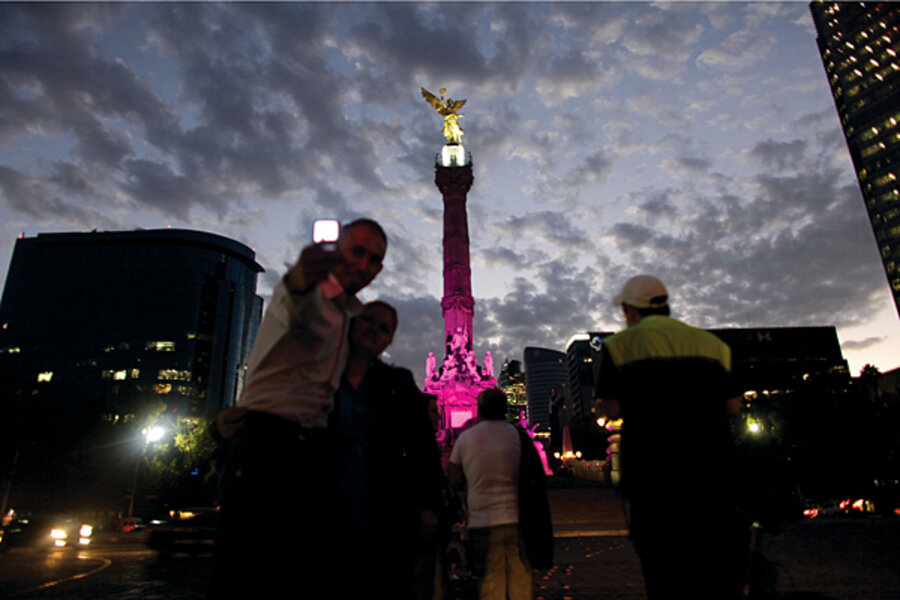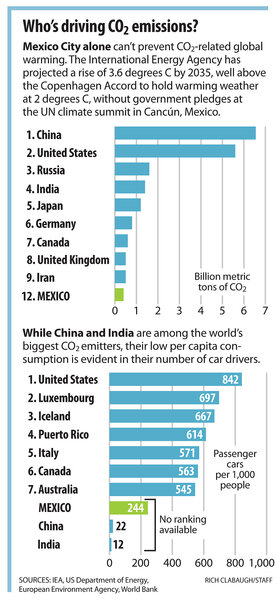As host of Cancún climate talks, Mexico shows off its greener capital city
Loading...
| Mexico City
Twenty years ago, news coverage of Mexico's pollution problem rang apocalyptic.
"Mexico City smog reaching record levels; disaster feared," read a 1992 headline in the Los Angeles Times. "Mexico turning into a gas chamber," the Calgary (Alberta) Herald exclaimed.
Mexico's capital was considered the world's most polluted city in the early '90s. Scientists measured alarming levels of lead, ozone, sulfur dioxide, and carbon monoxide in the air. Respiratory illnesses abounded. Runners donned surgical masks.
But the apocalypse never arrived. Among a host of initiatives, the government reduced road time for older cars, cut gasoline lead levels, and established emissions standards and verification procedures.
"Air quality has improved dramatically over the last decade," says Richard Fuller, president of the Blacksmith Institute in New York, which studies toxic hot spots around the globe. "It used to be one of the worst. Now it is a model."
As Mexico hosts the United Nations climate conference in Cancún through Dec. 10, with leaders from around the globe gathering to talk about a binding treaty to reduce greenhouse-gas emissions, the notoriously dirty capital is touting itself as a green city.
An ambitious 15-year "Plan Verde" promises to reduce vehicle emissions by 7 million metric tons before 2012 by investing in alternative energy, more green zones, and public transport such as electric buses. A bicycle program aims to sign up 24,000 users by February, from 17,000 today, says Martha Delgado, the city's environmental secretary.
"This is very exciting for a city that used to be one of the most polluted in the world," she says.
Mexico City has also signed a voluntary pact – together with 137 other cities present here Nov. 21 at the World Mayors Summit on Climate – to establish a monitoring and verification mechanism to track emissions. The pact is to be introduced at the climate conference in Cancún.
Over the past two decades, Mexico City has shown that it's committed to cleaning up, experts say. In 1991, ozone exceeded safe levels almost every day of the year. Skyscrapers were only visible as silhouettes. Thin air on the 7,300-foot-high plateau, ringed by mountains, was compounded by rapid urbanization as the metropolitan area septupled, from 3 million people in 1950 to 20 million. Chaotic roadways caused interminable commutes.
At the time, Luis Manuel Guerra, who directs the National Autonomous Institute of Ecological Studies, was measuring levels of ozone, particulates, carbon monoxide, and sulfur dioxide atop the roof of the German Embassy. The levels were so high, embassy officials told him, that in Germany they would qualify for an evacuation of staff.
World bodies began sounding alarm bells, stirring the government to action. A new hoy no circula (literally, "today it does not circulate") program grounded older cars for one day a week, an initiative replicated around the world. From nearly 350 days of unsafe ozone levels in 1991, that fell to 140 days in 2005, a level at which it has stabilized, says Mr. Guerra.
But skeptics say the real causes of contamination are being overlooked, and some of the most touted programs are failing. Humberto Bravo, an expert in environmental contamination at the National Autonomous University of Mexico (UNAM), says the hoy no circula program was never a success because residents bought older, more-polluting vehicles to drive on days their cars were idled. He says corruption has plagued initiatives such as vehicle exhaust verification systems.
Urban planning deserves more attention, says Professor Bravo, such as creating viable roadways that reduce the time that engines are running. Victor Magaña, another scientist at UNAM, says he supports many aspects of "Plan Verde" but worries that talk of emissions and global warming overshadows other causes of environmental destruction, such as mass urbanization.
All agree that the problem is far from solved. Ozone levels here still exceed safety standards. Particulates are also a problem. The city continues to sprawl.
"It achieved very impressive results," says Juan Carlos Belausteguigoitia, lead environmental economist at the World Bank. "The next generation of interventions is going to be more complicated, and will require more coordination."






